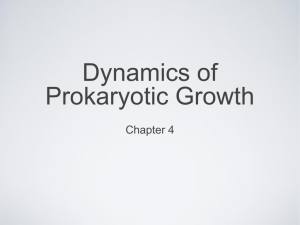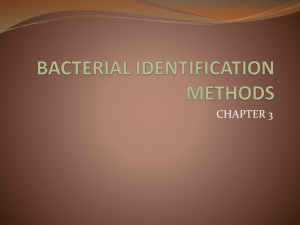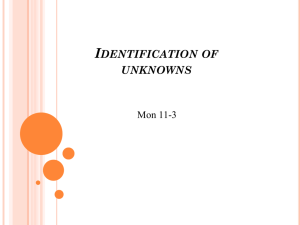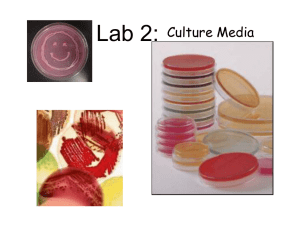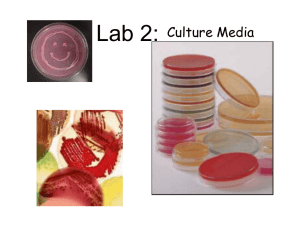Chapter 3,
advertisement
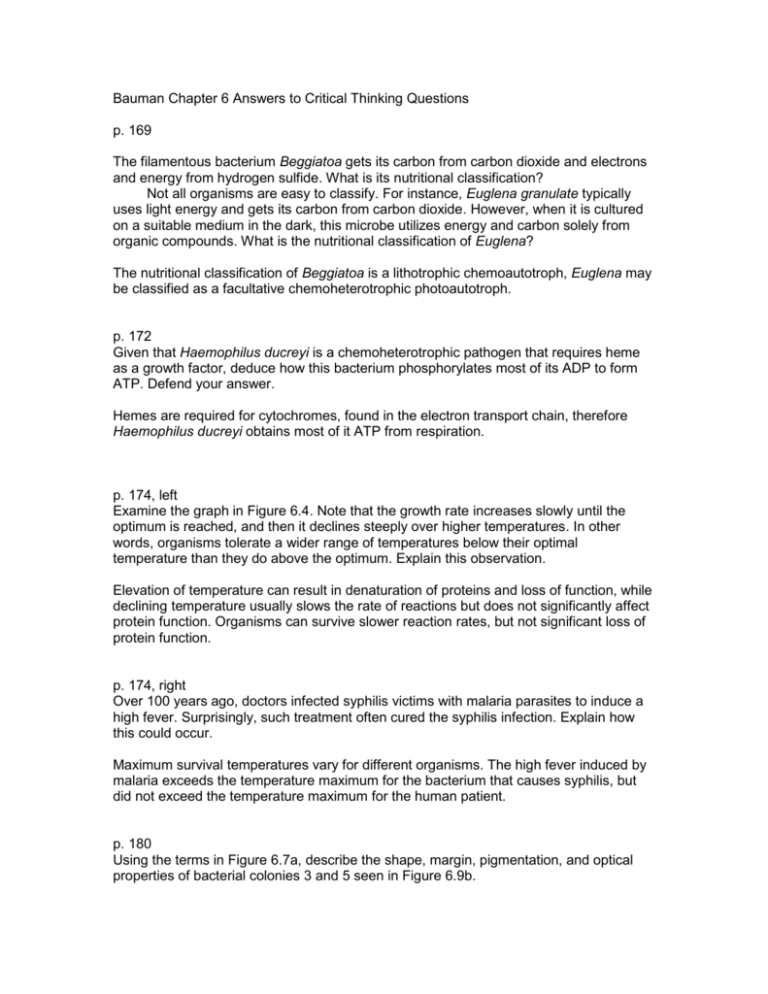
Bauman Chapter 6 Answers to Critical Thinking Questions p. 169 The filamentous bacterium Beggiatoa gets its carbon from carbon dioxide and electrons and energy from hydrogen sulfide. What is its nutritional classification? Not all organisms are easy to classify. For instance, Euglena granulate typically uses light energy and gets its carbon from carbon dioxide. However, when it is cultured on a suitable medium in the dark, this microbe utilizes energy and carbon solely from organic compounds. What is the nutritional classification of Euglena? The nutritional classification of Beggiatoa is a lithotrophic chemoautotroph, Euglena may be classified as a facultative chemoheterotrophic photoautotroph. p. 172 Given that Haemophilus ducreyi is a chemoheterotrophic pathogen that requires heme as a growth factor, deduce how this bacterium phosphorylates most of its ADP to form ATP. Defend your answer. Hemes are required for cytochromes, found in the electron transport chain, therefore Haemophilus ducreyi obtains most of it ATP from respiration. p. 174, left Examine the graph in Figure 6.4. Note that the growth rate increases slowly until the optimum is reached, and then it declines steeply over higher temperatures. In other words, organisms tolerate a wider range of temperatures below their optimal temperature than they do above the optimum. Explain this observation. Elevation of temperature can result in denaturation of proteins and loss of function, while declining temperature usually slows the rate of reactions but does not significantly affect protein function. Organisms can survive slower reaction rates, but not significant loss of protein function. p. 174, right Over 100 years ago, doctors infected syphilis victims with malaria parasites to induce a high fever. Surprisingly, such treatment often cured the syphilis infection. Explain how this could occur. Maximum survival temperatures vary for different organisms. The high fever induced by malaria exceeds the temperature maximum for the bacterium that causes syphilis, but did not exceed the temperature maximum for the human patient. p. 180 Using the terms in Figure 6.7a, describe the shape, margin, pigmentation, and optical properties of bacterial colonies 3 and 5 seen in Figure 6.9b. Colony 3: circular, entire, orange pigmented and translucent. Colony 5: circular, undulate, yellow pigmented and opaque. p. 182 Examine the ingredients of MacConkey agar as listed in Table 6.5 on page 184. Does this medium select for Gram-positive or Gram-negative bacteria? Explain your reasoning. The sole carbon source in citrate medium is citric acid (citrate). Why might a laboratory microbiologist use this medium? MacConkey agar growth medium contains bile salts and crystal violet. Most Gram positive bacteria do not grow well in the presence of these two components, therefore MacConkey agar selects for Gram-negative bacteria. Not all bacteria have the ability to metabolize citrate, and citrate metabolism is a characteristic used to identify bacteria (see Figure 4.31b for an example). p. 183 Using as many of the following terms that apply—selective, differential, broth, solid, defined, complex—categorize each of the media listed in Tables 6.4 and 6.5. The medium described in Table 6.4 is a selective defined simple broth medium. Table 6.5 MacConkey medium is a selective differential complex broth medium. Eosin methylene blue agar is a selective differential complex solid medium. Triple sugar iron agar is a differential complex solid medium. Blood agar is a differential complex solid medium. p. 186 Beijerinck used the concept of enrichment culture to isolate aerobic and anaerobic nitrogen-fixing bacteria, sulfate-reducing bacteria, and sulfur-oxidizing bacteria. What kind of selective media could he have used for isolating each of these four classes of microbes? Beijerinck may have used a simple defined medium containing no organic forms of nitrogen (amino acids, ammonium salts, or nitrites) to isolate nitrogen-fixing bacteria, then incubated in the lab for aerobic bacteria, or placed in a candle jar for anaerobic bacteria. Simple defined medium containing only sulfate as the sole potential electron acceptor may have been used to isolate sulfate-reducing bacteria, while a simple defined medium containing only sulfides as potential electron donors may have been used to isolate sulfur-oxidizing bacteria. p. 191 Viable plate counts are used to estimate population size when the density of microorganisms is high, whereas membrane filtration is used when the density is low. Why is a viable plate count appropriate when the density is high, but not when the density is low? Viable plate counts are determined by plating serial dilutions of the sample to be quantified, ensuring that at least one plating will have countable numbers of colonies in a statistically significant range, and is best used for samples with high densities of microorganisms. Plating a low microbe density sample even undiluted many yield such a low number of colonies that it is not statistically reliable, and further dilution will not improve the reliability of the count, so viable plate counts is not the method of choice for low density samples. p. 198 1. A microbiologist describes an organism as a chemoheterotrophic, aerotolerant, mesophilic, facultatively halophilic bacillus. Describe the organism’s metabolic and structural features in plain English. The organism is a rod-shaped prokaryote that tolerates oxygen and high salt conditions (but does not prefer these conditions), grows best at room temperature (or human body temperature), and requires organic sources of carbon and energy. 2. Pasteurization is a technique that uses temperatures of about 72oC to neutralize potential pathogens in foods. What effect does this temperature have on the enzymes and cellular metabolism of pathogens? Why does the heat of pasteurization kill some microorganisms yet fail to affect thermophiles? A temperature of 72oC exceeds the maximum survival temperature for many pathogens, at this temperature many proteins are denatured and metabolic pathways shut down without functional proteins. The optimum growth temperature of many thermophiles is temperatures around 72oC, so thermophiles grow well under pasteurization conditions. 3. If two cultures of a facultative anaerobe were grown under identical conditions except that one was exposed to oxygen and the other was completely deprived of oxygen, what differences would you expect to see between the dry weights of the cultures? Why? The dry weight of the culture grown in the presence of oxygen is much greater than the dry weight of the culture grown in the absence of oxygen. Oxygen is required for complete aerobic respiration of metabolites, without it much less chemical energy is recovered per molecule, and the metabolites are depleted in fewer generations than are able to grow in the presence of oxygen.

